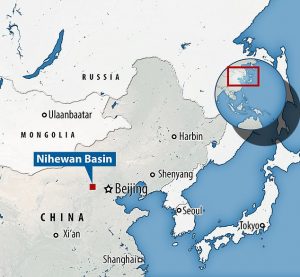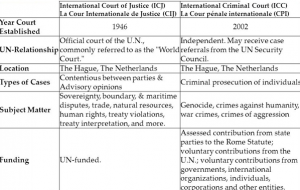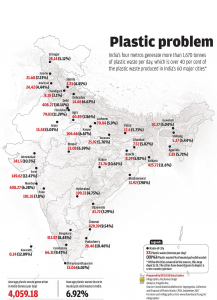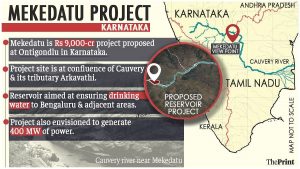Table of Contents
THE ENVIRONMENT & ECOLOGY
1. A HISTORIC RESOLUTION TO TACKLE PLASTIC POLLUTION
THE CONTEXT: In a historic move, more than 170 countries at the United Nations Environment Assembly (UNEA) in Nairobi, Kenya, agreed to establish an Intergovernmental Negotiating Committee that will develop an international, legally binding agreement to end plastic pollution by 2024.
THE EXPLANATION:
- Plastic pollution has emerged as one of the biggest environmental concerns worlds over. According to the World in Data, the world produced only 2 million tonnes of plastic per year in 1950. Since then, annual production has increased nearly 200-fold, reaching 381 million tonnes in 2015. A lot of plastic finds its way into natural systems and is also known to impact public health. At least 14 million tonnes of plastic end up in the ocean every year, according to the IUCN. Plastic makes up 80% of all marine debris found from surface waters to deep-sea sediments.
India’s Picture:
- According to data submitted in the Parliament in 2019, the Central Pollution Control Board (CPCB) estimates that India generates a whopping 25,940 tonnes of plastic waste per day. Of this, 60% is collected and recycled; the rest is littered in the environment. Some states have placed curbs on the use of some types of plastic. Himachal Pradesh, for instance, was the first state to ban plastic bags in 2009.
- By 2018, Maharashtra, Uttar Pradesh, Himachal Pradesh and Odisha imposed bans on plastic and thermocol.
- Earlier Centre had announced in both 2018 and 2019 that India would phase out single-use plastics by 2022. That, however, has not yet materialized. The environment ministry recently notified the new Plastic Waste Management Amendment Rules 2022, making it mandatory for plastic carry bags to be at least 120 microns thick: this will kick into effect from December 31, 2022. The rules also reportedly prohibit the manufacture, import, stocking, distribution, sale and use of several products with low utility but high littering potential.
Various Causes of Plastic Pollution
- Rapid urbanization and population growth increase the demand of cheap plastics.
- Since it is an affordable and durable material, it is utilized in every other way possible, from packaging materials to plastic bottles and containers, straws to plastic carry bags.
- Plastic takes 400 years and even more to Decompose. The decomposition rate of plastic typically ranges from 500 to 600 years, depending on the type.
- Abandoned Fishing Nets
- Disposal of plastic is often mismanaged; it ends up in landfills.
- Burning plastic is incredibly toxic and can lead to harmful atmospheric conditions and deadly illnesses.
Impact of Plastic Waste on Climate
- In 2015, greenhouse gas emissions from plastics were 1.7 gigatons of CO2 equivalent. By 2050, they’re projected to increase to approximately 6.5 gigatons. That number represents 15% of the whole global carbon budget.
- Plastic can also alter global carbon cycling through its effect on plankton and primary production in marine, freshwater and terrestrial systems.
Impact of Plastic Waste on Economy
- By 2040, there could be a $100 billion annual financial risk for businesses if governments require them to cover waste management costs. It can also lead to a rise in illegal domestic and international waste disposal.
Way forward:
- Policy shifts can reduce plastic pollution by incentivizing changes in both business and consumer behaviour, as well as in plastic design, alternatives and recycling.
- Governments can also impose taxes to deter the production or use of single-use plastics, or offer tax breaks, subsidies and other fiscal incentives to encourage alternatives to single-use plastic products.
- Product standards, certifications and labelling requirements can be designed to educate the public on the environmental impacts of plastic, and on the health and safety hazards involved in their production and use.
- Extended Producer Responsibility (EPR) programs can ensure that manufacturers maintain responsibility for single-use plastic products throughout the whole life cycles of those products.

2. NEW PLASTIC WASTE MANAGEMENT (AMENDMENT) RULES 2022
THE CONTEXT: The Ministry of Environment, Forest and Climate Change has published the Plastic Waste Management (Amendment) Rules, 2022 through which it has notified the guidelines on extended procedure responsibility for plastic packaging.
THE EXPLANATION:
The guidelines pave a roadmap for entities to shift towards sustainable plastic packaging. As per the notification, the new guidelines shall come to effect with immediate effect.
MAJOR HIGHLIGHTS OF PLASTIC WASTE MANAGEMENT (AMENDMENT) RULES, 2022
New Classification for plastic
The Plastic Waste Management (Amendment) Rules, 2022 seek to classify plastic in four primary categories as shown below:
- Category 1 will entail rigid plastic packaging;
- Category 2 shall entail flexible plastic packaging of an individual layer or multilayer (comprising different types of plastics, plastic covers & sheets made of plastic sheet, plastic sachet, carry bags.
- Category 3 shall include Multi-layered plastic packaging (comprising one layer of plastic and one layer of non-plastic).
- Category 4 shall include plastic sheets for carrying bags and packaging produced from compostable plastics.
Mandating PIBOs to share the detail of recycling certificates
- With regards to plastic packaging, the extended producer responsibility encompasses reutilization, recycling, use of recycled plastic content & end-of-life disposal by PIBOs (Producer Importers and Brand Owners).
- As per the new guidelines, the PIBOs shall have to facilitate the details pertaining to the recycling certificates only from authorized recyclers along with the particulars of quantity channelled for end of life disposal by June 30 of subsequent FY while filing annual returns on the web-based portal.
CPCB to launch a centralized web portal: A new web-based portal developed by CPCB shall reflect the plastic packaging material released into the marketplace by PIBOs in the FY. It will also manifest the particulars relating to the audit of the PIBOs and recyclers or other waste processors. The online system would serve as the single window data repository with regards to orders and directions relating to the deployment of EPR for plastic packaging under PWM rules, 2016.
Environmental compensation will be imposed based upon the polluter pays principle, with regard to non-compliance of EPR targets by PIBOs, to safeguard and improve the quality of the environment and restrain, curb, and lessen the pollution.
Carry forward of unfulfilled EPR directions: It also state that unfulfilled EPR directions for a given year shall be carried forward to the subsequent year for the duration of three years.
Inculcation of new committee by SPCB: According to the new guidelines, the GOI has declared the establishment of a committee formed by the State pollution control board under the chairpersonship of CPCB chairman to suggest measures to the ministry of environment for seamless implementation of EPR including amendments to EPR directions.
Annual Report on EPR: Plastic Waste Management (Amendment) Rules, 2022 mandate SPCBs or PCCs to furnish an annual report on the EPR web portal with regards to its fulfilment by PIBOs (which entail plastic packaging material manufacturers) & plastic waste processors in the State/UT to the CPCB.
THE ECONOMIC DEVELOPMENTS
3. YOUTUBE CREATORS CONTRIBUTED $894 MILLION TO INDIA’S GDP IN 2020
THE CONTEXT: According to Oxford Economics, published a report, where it says, YouTube creator ecosystem contributed Rs 6,800 crore to the Indian economy. The Google-owned online video platform also supported 6,83,900 full-time equivalent jobs in India in 2020.
THE EXPLANATION:
- The report claims that YouTube has become a significant tool for small and medium sized business (SMB’s).” Through their own channel, targeted adverts or simply from watching You Tube content, businesses have successfully grown sales and connected with customers”.
- Terming the YouTube community an “emerging soft power”. “As our creators and artists build the next generation of media companies that are connecting with a global audience, their impact on the economy’s overall success will only continue to accelerate.”

THE INTERNAL SECURITY AFFAIRS
4. VILLAGE DEFENCE COMMITTEE IN JAMMU
THE CONTEXT: The Ministry of Home Affairs’ decision to revive the infamous village defence committees (VDCs) as village defence groups across Jammu and Kashmir contradicts the government’s claims about normalcy in the Union territory.
THE EXPLANATION:
- The Ministry of Home Affairs has approved a “Revised Scheme of Village Defence Groups (VDGs) in J&K” under which the erstwhile village defence committees will be designated as village defence groups.
- In more vulnerable areas the order provides that people who lead these village defence groups will be paid an honorarium of Rs 4,500 per month and other persons who are voluntary members of these groups will be paid an honorarium of Rs 4,000 a month for their participation.
- The use of civilians to aid in law enforcement is not something new in India. The Police Act, 1861, provides for the appointment of special police officers (SPOs) if a magistrate determines they are required. The appointment is more of a conscription as if a person fails to respond to the request they can be punished under the Act. However, their deployment in conflict zones like Jammu and Kashmir does raise certain issues, particularly, from a human rights perspective.
- There are three broad categories of armed forces that may be used in a conflict zone: regular military force, paramilitary force and the police force. The village defence guards will be under the supervision of the local police. Accordingly, they will constitute an extension of the third category.
Background:
- VDCs were first set up in J&K during the 1965 war. They were also used to keep a check on cross-border infiltration during the 1971 war.
- VDC policy in 1995, the Union Home Ministry unveiled a village defence committee (VDC) policy “to organise a small group, of volunteer armed civilians, in the identified villages along the borders as well as in-depth areas of Jammu division… to ensure the safety and security of such villages, infrastructural installations in and around them and to check the trans-border movement”.
- According to MHA, in recent years, as the situation started showing signs of improvement in Jammu and Kashmir, the VDCs also began to lose their clout. Due to paltry pay, which hasn’t been paid to them for nearly four years now, most of the VDCs have become dysfunctional.
THE PRELIMS PERSPECTIVE
5. OLD STONE AGE CULTURE DISCOVERED IN CHINA
THE CONTEXT: Scientists discovered remnants of an Old Stone Age culture, less than 100 miles (160 kilometers) west of Beijing, where ancient hominins used a reddish pigment called ochre and crafted tiny, blade-like tools from stone. The archaeological site, called Xiamabei, offers a rare glimpse into the life of Homo sapiens and now-extinct human relatives who inhabited the region some 40,000 years ago.
THE EXPLANATION:
The newly excavated site lies within the Nihewan Basin, a depression in a mountainous region of northern China. The excavation team found evidence of the culture about 8 feet (2.5 meters) underground, when they spotted a layer of dark, silty sediment that dated to between 41,000 and 39,000 years ago, based on radiocarbon dating and other analyses.
This Stone Age sediment contained a treasure trove of artifacts and animal remains, including more than 430 mammal bones; a hearth; physical evidence of ochre use and processing; a tool made of bone; and more than 380 miniaturized lithics, or small tools and artifacts made of chipped or ground stone.
Based on the available evidence, however, they could not determine exactly how the pigment was used. Ochre can be used in adhesives, for example, or in “symbolic applications” such as rock art paint or paint that’s applied to the body as both cosmetic decoration and sunscreen.
According to excavators, “Distinguishing between symbolic and functional uses of ochre in the material culture record is an ongoing challenge for prehistoric archaeologists.”

Value Addition:
What is Carbon Dating?
Radiocarbon dating or carbon dating or carbon-14 dating is a method for determining the age of an object containing organic material by using the properties of radiocarbon, a radioactive isotope of carbon. Unstable carbon-14 gradually decays to carbon-12 at a steady rate
How does it work?
- Radiocarbon dating works by comparing the three different isotopes of carbon. Isotopes of a particular element have the same number of protons in their nucleus but different numbers of neutrons. This means that although they are very similar chemically, they have different masses.
- The total mass of the isotope is indicated by the numerical superscript. While the lighter isotopes 12C and 13C are stable, the heaviest isotope 14C (radiocarbon) is radioactive. This means its nucleus is so large that it is unstable.
6. MEKEDATU PROJECT
THE CONTEXT: Karnataka plans to construct a balancing reservoir or a storage dam built downstream of the main reservoir to capture excess water that flows out – over the river Cauvery. Estimated to cost around Rs 9,000 crore, also the state believes it would resolve the drinking water shortage in the districts of Bengaluru and Ramanagara and also generate hydroelectricity to meet the power needs of the state.
THE EXPLANATION:
WHAT IS THE MEKEDATU PROJECT ?
Named after the village where the project is expected to be constructed, the reservoir will have a capacity of 284,000 million cubic feet (TMC). It is proposed to be built over the Cauvery River, which is why Tamil Nadu has been vehemently opposing it.
PARCHED BENGALURU
- According to a 2021 report, Karnataka at a Glance by the Directorate of Economics and Statistics, Bengaluru’s urban population was 96.21 lakh in 2011 and was projected to rise to 1.42 crore by 2021. Located in a semi-arid peninsular plateau region, the city relies heavily on two rivers, Cauvery and Arkavathi to meet its water needs.
- Bangalore Water Supply and Sewerage Board (BWSSB) calculates the demand for water to be 1,400 million per day (MLD).
- However, there have been several reports claiming that Bengaluru will go dry in the next few decades.
- An analysis by the Centre for Science and Environment (CSE) also found that the total number of extraction wells in the city had shot up from 5,000 to 4,50,000 in the past 30 years.
- The environmental perspective, it is hugely destructive to the Cauvery wildlife and river life.
- Reports by entities like NITI Aayog claiming that Bengaluru will be among India’s 21 cities to run out of groundwater soon sound alarmist.

THE PRELIMS PRACTICE QUESTIONS
QUESTIONS OF THE DAY 4TH MARCH 2022
Q. Consider the following statements about Theyyam:
- It is a popular ritual form of dance worship in Kerala.
- It is only performed by males.
- There is no stage for the performance.
Which of the given statements is/are correct?
a) 1 only
b) 2 and 3 only
c) 1 and 3 only
d) All of them
ANSWER FOR 3RD MARCH 2022
Answer: 1 & 2
Explanation:

Spread the Word




